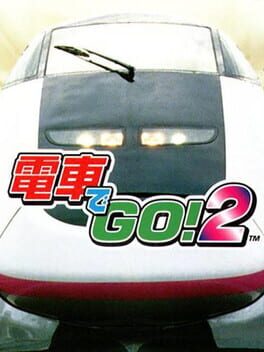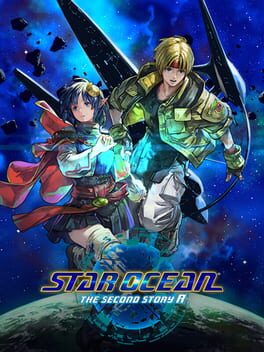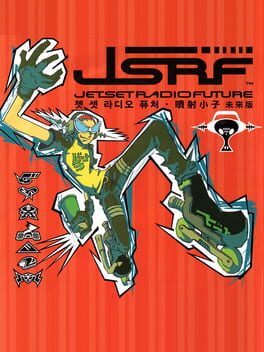sludgetoxin
4 reviews liked by sludgetoxin
Densha de Go! 2
1998
Ok, a few things first:
Densha de GO! 2: Kōsoku-hen is a FAR superior game in comparison to the first Densha de GO!. The content was greatly expanded, with many more stages to play (in comparison to the first game having only four diagrams) and trains to drive (with the notable inclusion of the Shinkansen bullet trains), being not only more fun to play, but also to look at and to listen to.
I LOVED playing DDG2. I truly did.
However, I’m rating it with a 3.5 out of 5 stars (which, in my books, qualifies as a “GOOD” game), since it has its own fair share of flaws, that can - and, sometimes, WILL - make the game a bit infuriating to play.
First of all, they removed the little map that shows you an overview of the train reaching a station you’re supposed to stop at, a feature present in the first game that greatly helps you landing at the right spot and at the right speed. That, by itself, makes it somewhat more strict than the previous game.
Densha de GO! was already very strict and, as an arcade game, there was a fair amount of memorisation of the routes required to drive through its stages; in DDG2, despite enjoying it more than the first game, I couldn’t help but to think there is a bit more of strictness around it as a whole, a lot more of memorisation going on.
Of course, there are more challenging routes to take here, but some of these require you to be virtually flawless in your actions, and it’s HARD to achieve that when you’re at, say, 130km/h on a Shinkansen and a sign pops out of freaking nowhere telling you to reduce your speed to 45km/h… which, if you don’t manage to pull off within mere seconds (and, in this example here, you simply CAN’T), you’ll be obscenely penalised.
So, yeah, if there was a lot of memorisation going on in DDG, it was quadrupled in its sequel.
That being said, and knowing that, after this one, the series took a more home-console gaming approach, with maps of the tracks showing signs ahead of time to prevent you from being miserably slapped on the face by them (thus, reducing the amount of route memorisation by a wide margin, without taking the challenge and the fun out of it), I feel prevented of giving it a higher score, despite loving to play it.
With all of that in mind, I think this is the best title in the Densha de Go! franchise for beginners, especially if you start by playing the Nintendo 64 version, which not only has an exclusive Beginner Mode, but it’s also been fully translated by fans into English, which is a must for western players to learn the intricacies of the gameplay.
Since it doesn’t have some of the QoL improvements of the later games, it’s not too easy, and learning to play with these handicaps in mind will prevent you from developing wrong or less-than-optimal techniques; also, despite being possibly more strict than the first game, it’s way more varied, and you’ll find yourself playing and replaying these stages for the mere fun of it.
With all of that, I think this is the perfect representation of the “classic” DDG experience, and certainly milestone in the series.
Note that there’s an updated version available, called Densha de GO! 2: Kōsoku-hen 3000-bandai, which got ported over to the Dreamcast (with better graphics, of course) and also to which the Nintendo 64 version was based upon. It has some additional and exclusive stages, and was released to celebrate the 3000 active DDG 2 arcade machines at the time; overall, it’s considered to be the most complete version of the game.
However, despite having the means to play this version, I still found myself always coming back to this PlayStation version… and I’m not really sure why, but I guess I simply prefer the overall presentation here.
Here, the announcer’s voice is unique, and Tetsu (the cute conductor lady) was also voiced; the “congratulations” pictures displayed after a completed stage have much more quality of definition; there are, by default, different speedometers for each different type of train, which definitely makes the gameplay more varied and visually appealing; and the train’s sounds, like the engine or the noise going on with the tracks, simply felt more pleasant to my ears in this version.
Besides that, there’s the exclusive “Material Hall of Train” extra section, where you can unlock lots of pictures of different types of Japanese trains, each containing its respective trivia (which won’t matter if you can’t read Japanese of course, but at least looking at the pictures is cool enough), as well as 3D models of the trains you drive in the game.
And, lastly, there’s also the Osaka Loop Line and the Kagoshima Main Line, exclusive stages within this version.
All of that made this PS1 port of DDG2, to me, much more charming than its counterparts.
I’ll always recommend the N64 version for newcomers, for its Beginner Mode and English language option, but, trust me, after you learn how to play it, the language barrier becomes basically nonexistent, and you’ll find yourself being perfectly capable of playing any other game in the series despite all of them being written in moonrunes.
For the ones interested in getting into train simulation games (I’m a newcomer myself), I truly believe Densha de GO! 2: Kōsoku-hen is one of the finest entries out there, and definitely worth it checking out. These games present the perfect mix of simulation and fun arcade gameplay, being one of the most fun and charming videogame experiences I’ve had in quite a while.
Densha de GO! 2: Kōsoku-hen is a FAR superior game in comparison to the first Densha de GO!. The content was greatly expanded, with many more stages to play (in comparison to the first game having only four diagrams) and trains to drive (with the notable inclusion of the Shinkansen bullet trains), being not only more fun to play, but also to look at and to listen to.
I LOVED playing DDG2. I truly did.
However, I’m rating it with a 3.5 out of 5 stars (which, in my books, qualifies as a “GOOD” game), since it has its own fair share of flaws, that can - and, sometimes, WILL - make the game a bit infuriating to play.
First of all, they removed the little map that shows you an overview of the train reaching a station you’re supposed to stop at, a feature present in the first game that greatly helps you landing at the right spot and at the right speed. That, by itself, makes it somewhat more strict than the previous game.
Densha de GO! was already very strict and, as an arcade game, there was a fair amount of memorisation of the routes required to drive through its stages; in DDG2, despite enjoying it more than the first game, I couldn’t help but to think there is a bit more of strictness around it as a whole, a lot more of memorisation going on.
Of course, there are more challenging routes to take here, but some of these require you to be virtually flawless in your actions, and it’s HARD to achieve that when you’re at, say, 130km/h on a Shinkansen and a sign pops out of freaking nowhere telling you to reduce your speed to 45km/h… which, if you don’t manage to pull off within mere seconds (and, in this example here, you simply CAN’T), you’ll be obscenely penalised.
So, yeah, if there was a lot of memorisation going on in DDG, it was quadrupled in its sequel.
That being said, and knowing that, after this one, the series took a more home-console gaming approach, with maps of the tracks showing signs ahead of time to prevent you from being miserably slapped on the face by them (thus, reducing the amount of route memorisation by a wide margin, without taking the challenge and the fun out of it), I feel prevented of giving it a higher score, despite loving to play it.
With all of that in mind, I think this is the best title in the Densha de Go! franchise for beginners, especially if you start by playing the Nintendo 64 version, which not only has an exclusive Beginner Mode, but it’s also been fully translated by fans into English, which is a must for western players to learn the intricacies of the gameplay.
Since it doesn’t have some of the QoL improvements of the later games, it’s not too easy, and learning to play with these handicaps in mind will prevent you from developing wrong or less-than-optimal techniques; also, despite being possibly more strict than the first game, it’s way more varied, and you’ll find yourself playing and replaying these stages for the mere fun of it.
With all of that, I think this is the perfect representation of the “classic” DDG experience, and certainly milestone in the series.
Note that there’s an updated version available, called Densha de GO! 2: Kōsoku-hen 3000-bandai, which got ported over to the Dreamcast (with better graphics, of course) and also to which the Nintendo 64 version was based upon. It has some additional and exclusive stages, and was released to celebrate the 3000 active DDG 2 arcade machines at the time; overall, it’s considered to be the most complete version of the game.
However, despite having the means to play this version, I still found myself always coming back to this PlayStation version… and I’m not really sure why, but I guess I simply prefer the overall presentation here.
Here, the announcer’s voice is unique, and Tetsu (the cute conductor lady) was also voiced; the “congratulations” pictures displayed after a completed stage have much more quality of definition; there are, by default, different speedometers for each different type of train, which definitely makes the gameplay more varied and visually appealing; and the train’s sounds, like the engine or the noise going on with the tracks, simply felt more pleasant to my ears in this version.
Besides that, there’s the exclusive “Material Hall of Train” extra section, where you can unlock lots of pictures of different types of Japanese trains, each containing its respective trivia (which won’t matter if you can’t read Japanese of course, but at least looking at the pictures is cool enough), as well as 3D models of the trains you drive in the game.
And, lastly, there’s also the Osaka Loop Line and the Kagoshima Main Line, exclusive stages within this version.
All of that made this PS1 port of DDG2, to me, much more charming than its counterparts.
I’ll always recommend the N64 version for newcomers, for its Beginner Mode and English language option, but, trust me, after you learn how to play it, the language barrier becomes basically nonexistent, and you’ll find yourself being perfectly capable of playing any other game in the series despite all of them being written in moonrunes.
For the ones interested in getting into train simulation games (I’m a newcomer myself), I truly believe Densha de GO! 2: Kōsoku-hen is one of the finest entries out there, and definitely worth it checking out. These games present the perfect mix of simulation and fun arcade gameplay, being one of the most fun and charming videogame experiences I’ve had in quite a while.
This game is one of the best JRPGs that still holds up extremely well with this remade version making it even more accessible.
The game is extremely fun pretty much the entire time. The combat is some of the most fun in terms of action-like combat systems in JRPGs although it does get a little messy later in the game once your party and the enemies are spamming spells and abilities.
There is a pretty unique skill system that is really fun to engage with but can also be safely ignored for the most part (if you wish). You are able to invest points into a variety of skills that allow you to combine healing items, craft weapons, upgrade weapons, add secondary abilities to equipment, play music, cook food, summon a mount, summon superbosses, reduce your stats for more experience....you get the gist.
I think if you are a fan of JRPGs and have never played this you owe yourself a favor to do so.
The game is extremely fun pretty much the entire time. The combat is some of the most fun in terms of action-like combat systems in JRPGs although it does get a little messy later in the game once your party and the enemies are spamming spells and abilities.
There is a pretty unique skill system that is really fun to engage with but can also be safely ignored for the most part (if you wish). You are able to invest points into a variety of skills that allow you to combine healing items, craft weapons, upgrade weapons, add secondary abilities to equipment, play music, cook food, summon a mount, summon superbosses, reduce your stats for more experience....you get the gist.
I think if you are a fan of JRPGs and have never played this you owe yourself a favor to do so.


